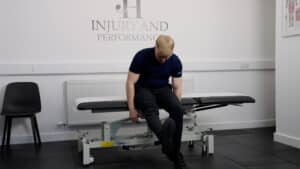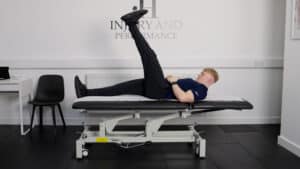This blog post tackles everything sciatica, from what it is to how to finally ditch it and prevent it from coming back.
What is Sciatica?
The sciatic nerve is your body’s longest and thickest nerve, running all the way from your lower spine, down the hamstring before it splits off just behind the knee into the tibial nerve and the common peroneal nerve. Sciatica itself isn’t an injury, but rather a symptom of an underlying issue that pinches or irritates this nerve.
Causes of Sciatica
There are a few culprits behind sciatica, including:
- Degenerative changes in the spine
- Disc herniations (bulging or displaced discs)
- Muscle spasms
Any of these can compress the sciatic nerve, leading to pain and discomfort.
Symptoms of Sciatica
Sciatica symptoms can range massively; here’s what you might experience:
- Lower back pain
- Pain radiating down the glutes and leg
- Shooting, burning, or sharp pain
- Numbness or tingling
- Muscle weakness
Testing for Sciatica at Home
There are two simple tests you can try at home to see if sciatica might be the issue:
- Slump Test: Lie down with one leg extended and the other bent, toes tucked. Slowly slump forward with your chin tucked. Pain in your lower back or glutes suggests sciatic nerve involvement.
- Straight Leg Raise Test: Lie down on your back with one leg bent. Slowly raise the straightened other leg until you feel tightness or pain in the back of your leg. This test is similar to the Slump Test but isolates the straight leg.
Remember, these are just home tests, and consulting a healthcare professional is always recommended for proper diagnosis.
Exercises to Beat Sciatica
Rehab is key to managing sciatica. Here are some exercises that can help:
- Lumbar flexion
- Lumbar extension
- Lumbar side flexion
- Piriformis stretch
- Bridge
- Clam
Additional Treatments for Sciatica
Combine rehab exercises with other treatments for a well-rounded recovery plan. This might include:
- Soft tissue work
- Manual mobiliations
- Heat therapy
- Staying active (avoiding activities that aggravate symptoms)
- Pain management with medication (remember, medication shouldn’t be an excuse to exercise through pain)
Preventing Sciatica
I look at preventing sciatica as a three-pronged approach:
- Education: Understand your body and the causes of sciatica.
- Strengthening: Build strong muscle groups for better support.
- Mobility: Maintain flexibility and good range of motion in your joints and muscles.
Stay tuned for more injury prevention tips and be sure to get in touch if you have any questions!
If you’d like to book an appointment, please go to my contact page – https://jhinjuryperformance.com/contact


